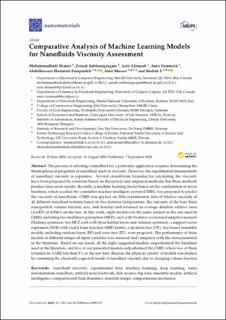| dc.description.abstract | The process of selecting a nanofluid for a particular application requires determining the thermophysical properties of nanofluid, such as viscosity. However, the experimental measurement of nanofluid viscosity is expensive. Several closed-form formulas for calculating the viscosity have been proposed by scientists based on theoretical and empirical methods, but these methods produce inaccurate results. Recently, a machine learning model based on the combination of seven baselines, which is called the committee machine intelligent system (CMIS), was proposed to predict the viscosity of nanofluids. CMIS was applied on 3144 experimental data of relative viscosity of 42 different nanofluid systems based on five features (temperature, the viscosity of the base fluid, nanoparticle volume fraction, size, and density) and returned an average absolute relative error (AARE) of 4.036% on the test. In this work, eight models (on the same dataset as the one used in CMIS), including two multilayer perceptron (MLP), each with Nesterov accelerated adaptive moment (Nadam) optimizer; two MLP, each with three hidden layers and Adamax optimizer; a support vector regression (SVR) with radial basis function (RBF) kernel; a decision tree (DT); tree-based ensemble models, including random forest (RF) and extra tree (ET), were proposed. The performance of these models at different ranges of input variables was assessed and compared with the ones presented in the literature. Based on our result, all the eight suggested models outperformed the baselines used in the literature, and five of our presented models outperformed the CMIS, where two of them returned an AARE less than 3% on the test data. Besides, the physical validity of models was studied by examining the physically expected trends of nanofluid viscosity due to changing volume fraction | en_US |

